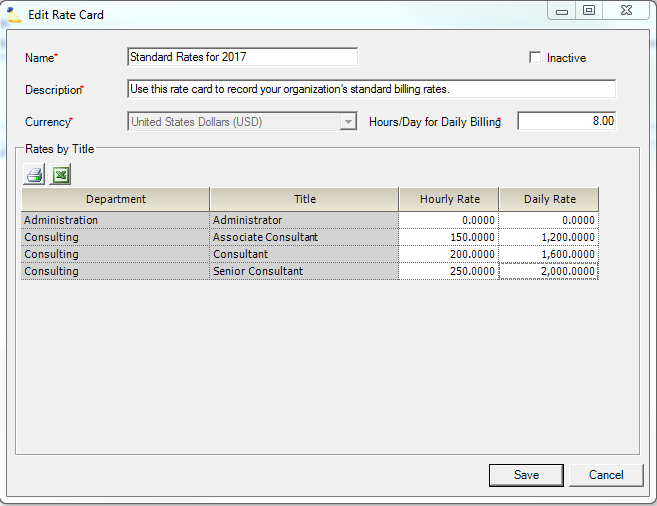Rate Cards - Billing Rates (CQ)
Rate cards are set in Rate Management | Rate Cards.
Your account will start with one billing rate card which is named "Standard Rates for 2017" (the year will vary based on when you sign up). The rate card will be denominated in your organization's main currency. You may create as many rate cards as needed. Since billing rates can be overridden for each role on each project you won't need to create many rate cards. If there are a few rate cards that you use repeatedly, then it makes sense to create those in Projector. Since the project's rate card determines the project's billing currency you will need to create at least one rate card per currency in which you intend to bill your customers.
A rate card is a list of titles with associated hourly and daily billing rates. Therefore the rate card will have one row per title you created in the Department and Titles page. Based on the example above, the standard rate card would be:
Note that there is one hourly and one daily rate per department/title combination. By editing a rate card (shown above) you can set a rate for each title on that rate card. By editing a title (in Departments and Titles) you can set a rate for each rate card for that title.
By assigning a rate card to a cost center you are establishing standard billing rates for that cost center. These rates can be overridden based on the client, project, role, and task type. To override rates at the task type level, you need to apply rate types to the task types. Rate types affect the RDC (resource direct cost) of reported time, not of scheduled (forward-looking) time.
If you commonly bill your clients the same rate for all resources for each project then consider creating a billing rate card where the rate for all titles is $100/hour (actually, create one like this per billing currency). When you apply the rate card to a project you can specify a discount (positive or negative) so that you can easily set any rate without needing to create a lot of rate cards.
